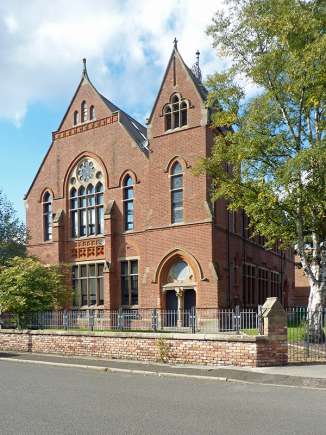School Chapel Rooden Lane Prestwich (Heaton Park Congregational Church)
Confusion reigns. Seemingly based upon no more than local legend, English Heritage still continue to ascribe the building to Alfred Waterhouse. When no record of this commission was found in the Waterhouse archives Pevsner (Lancashire: Manchester and the South East 2004 page 568) ascribed it to G T Redmayne. Contemporary reports indicate that neither is correct. In part this is a result of such reports referring to the original name of the district – Rooden Lane, rather than its current name of Heaton Park. These nineteenth century reports consistently name Royle and Bennet as architects for the Rooden Lane (Later Heaton Park) Congregational Church and Sunday School.
A falling congregation led to the building being sold for conversion into apartments in 2006-7 with a much smaller church being built as part of the development at one end of the site. This has now closed
ROODEN LANE CONGREGATIONAL MISSION – Since 1862 a mission connected firstly with the Cheetham Hill Congregational Church and latterly with the Broughton Park Congregational Church, has been conducted with considerable success at Rooden Lane Prestwich. A schoolroom was opened in 1865 and a few years later a school for infants was added, whilst further accommodation his since been secured by the rental of an adjoining cottage. The average attendance of scholars is 100 in the morning and 150 in the afternoon, whilst the congregation at the evening services averages considerably over 100. The various agencies connected with the mission including the Savings Bank, Band of Hope, and Reading Club are all in active operation. Consequent upon the opening of the new railway to Bury, the population of the district is increasing, and the Broughton Park church and friends at Rooden Lane have resolved to erect a new school-chapel. This was commenced on Saturday by the laying of the foundation stone. The building will consist of two storeys, the ground floor being a school-room capable of accommodating 400 scholars, and the first floor will be used as a chapel, with four large classrooms and a minister’s vestry. The cost will be £4,000, about £2,600 of which has already been promised. Messrs Royle and Bennett of this city are the architects, and the contractors are Messrs Southern of Salford. At the ceremony on Saturday there was a numerous attendance, among those present being Mr Henry Lee MP, the Rev C S Slater, the Rev T Wilis, the Rev E Salt (Wesleyan) the Rev J M M’Dougall, the rEv G Hughes, Mr J Bancroft, Mr John Lee, Mr W T Rymer, Mr M Ogden, Mr T Roberts and Mr G Harker. The stone was laid by Mr H Lee, who, in the course of a brief address, said that the promoters of the building were carrying on the work from no spirit of rivalry, but simply from a desire to advance the spiritual welfare of the surrounding population. [Manchester Guardian 4 April 1881 page 8]
ROODEN LANE NEW CONGREGATIONAL CHURCH AND SUNDAY SCHOOLS – Opening Services. Recognition Service of Mr Griffith D Hughes, tomorrow (Saturday) at 3.30pm, Rev R W Dale M A and others to take part. Sunday 13 November, morning 10.30 am, Rev R W Dale MA; afternoon 3.00pm Rev Griffith D Hughes; evening 6.30pm Rev C S Slater MA. Mr Dale with preach at Broughton Park Congregational Church at 6.30 on Sunday evening. Collections in aid of the building Fund at all services. [Manchester Guardian 11 November 1881 page 1
BROUGHTON PARK CONGREGATIONAL CHURCH – A bazaar in aid of a fund for the erection of a school-chapel in connection with Broughton Park Congregational was opened by Mr Hugh Mason MP yesterday. The site of the new building is in Rooden Lane, Higher Broughton (sic). …. The new building, a handsome structure, is being built from designs by Messrs Royle and Bennett, Manchester. The school chapel will have a large school-room and commodious classrooms on the ground floor, and on the upper floor a spacious and beautiful chapel with vestry and additional classrooms. The cost of the building is estimated at £4,000. [Manchester Guardian 21 October 1881 page 5]
In 1881 a new building, within a few minutes-walk of Heaton Park Station, was erected on land which had been previously purchased by Henry Lee, Esq, of Sedgley Park, and Thomas Rymer Esq. It was opened in November of that year by Dr. Dale, of Birmingham. It is in Gothic style, with a schoolroom on the ground floor affording space for 400 scholars, and the chapel itself has been arranged to accommodate the same number of persons. The total cost was about £4,525, which was met by subscriptions and a grant of £500 from the Chapel Building Society. The Rev. G. D. Hughes, a Lancashire College student, was appointed minister, beginning his duties as such with the opening of the building. ["Lancashire Nonconformity, or, Sketches, historical and descriptive, of the Congregational and old Presbyterian churches in the county" Rev B Nightingale 1893]
Reference Manchester Guardian 4 April 1881 page 8 – foundation stone
Reference Manchester Guardian 21 October 1881 page 5
LISTING TEXT - Heaton Park Congregational Church - II 2. Congregational church. 1881 by Alfred Waterhouse. Red brick with pressed brick and stone dressings, steeply pitched slate roofs. Gothic Revival. School room/hall on ground floor, church above. Separately-roofed buttressed corner tower contains entrance, a twin doorway in arched opening, with traceried tympanum and hood-mould. Lancet stairlights leading up to church, which has similar lancets and a large 4-light plate-traceried arched window in the gable end. Triplets of little lancets in both main gable and tower, similar in form but differing in detail. Louvre to tower roof ridge with decorative ironwork. Ground floor hall windows square headed (though with expressed relieving arches) with mullions and transoms. Stained glass to church. Original staircases, doors and interior fittings intact. A good and complete example of the work of Waterhouse, economically planned and sensitively detailed.
